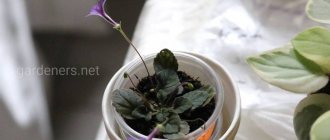Violets are valued for their beauty, compactness and symmetry. For a perfect, correct socket you need to put in a little effort.
Symmetry is achieved with proper lighting ; the horizontality of the leaves depends on proper care .
If you violate the rules of care, the rosette will never be perfect, and this is very important, especially for gardeners who exhibit their plants at exhibitions or sell them. That is why we want to devote this article to the topic “How to properly form a violet bush.”
Aesthetics of the Saintpaulia rosette
The aesthetics of the rosette is very important for everyone , both for amateur flower growers and for professionals who grow flowers for exhibitions and for sale.
Also, the correct formation of the rosette affects flowering; in evenly developed violets, flower stalks are formed on different sides, there are more of them and they look better than on asymmetrical ones.
Correctly formed violet rosette.
A violet rosette is rows of leaves gathered around a low stem, at the top of which is a growing point. Ideally, the rosette has a perfectly round symmetrical shape (when viewed from above). Not only the aesthetic appearance, but also the normal development of Saintpaulia depends on this.
In a correct rosette, the leaves are horizontal; if they rise upward, this indicates errors in care.
What is a stepson
A single point of growth using the example of a growing violet variety AE-Milky Way
The photo above shows where the single growth point of a young violet is located. There shouldn't be others.
But how often do they appear - stepchildren. This is a daughter rosette growing between the leaves. It has no roots, because there is one “channel” of nutrition with the stem and the entire plant.
Using the example of a young violet variety RS-Musical
I specially increased them to make a publication. I should have removed it as soon as I noticed it.
How to form a violet?
Technology
It is important to start the formation of violets from the very beginning, from planting. When planting a violet in a pot or replanting it in a new one, it is necessary to place the stem exactly in the center.
The growth and development of the top part depends entirely on the development of the roots. If you plant a violet closer to one of the edges of the pot, the castings on this side will be smaller and there may be fewer of them.
The violet grows from the center, this is where the growth point is located. This place is very sensitive and the slightest mistakes in this area lead to unevenness of the rosette, and possibly to the death of the flower. Water entering the growing point is detrimental to the violet , and sunburn spoils the appearance of the plant for a long time until the leaves grow.
A common problem for gardeners who want to get the perfect rosette is stepsons . They grow under the leaves and spoil the appearance , the leaves next to them rise, and the rosette ceases to be symmetrical.
There is a solution, the stepchildren can be cut off when they are still small or you can wait until they grow a little, it all depends on the urgency of bringing the socket into perfect condition.
Advice! Stepchildren can be rooted and a new individual can be obtained. If it is important to preserve the ideality of the rosette and the stepsons are removed when they are very small, it is difficult to root them, but those with at least two leaves should take root successfully.
There is a misconception that a perfectly symmetrical rosette can be formed only with correctly placed lighting, but the choice of lighting option depends on the conditions and capabilities:
- natural light. Under natural light, symmetry can be achieved by regularly rotating the pot. The frequency of turns depends on the light intensity; southern windows with shading from direct rays, using tulle or a special film, are best suited;
Violets in natural light should be rotated regularly.
- artificial lighting. Sockets under artificial light also need to be rotated; without this procedure, only the individual located directly under the point of light can grow evenly. If you install long lamps above the violets, you can place the pots in three rows and the two outer ones will need to be rotated.
The amount of light is very important , because even proper care and regular turns will not help if there is not enough light. The appearance of the violet will indicate whether there is enough light.
If there is insufficient lighting, the leaves change color and become paler (in variegated leaves this causes a large number of white zones on the leaves). Also, insufficient lighting leads to lifting of leaves , so they are drawn towards the light, and the leafy stems in this case are stretched.
Old, wilted leaves also spoil the appearance of the rosette . They need to be removed on time and correctly, because they not only spoil the appearance, but also draw additional substances from the plant that can be used for the growth and development of young leaves.
The leaf needs to be removed if it loses turgor for no reason, begins to wither or dry out , it is best to cut it with a sharp knife. It is advisable to remove not just one sheet, but the entire row. This is necessary to maintain appearance.
Advice! If only half of the leaves in the row have withered, the rest can be rooted.
During the growth period, it is important to feed the violet correctly. To gain green mass before the first flowering, violets are fed with fertilizers for ornamental foliage plants once every two weeks. This inhibits the development of the first flower stalks, giving enough time and nutrients for good and proper development of the rosette and roots.
When the violet, in the opinion of the grower, is ready for the first flowering, fertilizing is carried out with fertilizers for flowering ones or specialized for Saintpaulias .
Bush pruning
An important factor in the formation of a rosette is pruning and control of the formation of young leaves and peduncles. How to properly prune a violet at home step by step:
- extra sheets. Sometimes leaves form on the rosette, which spoil the symmetry or have stems that are too long. When removing such sheets, it is important to remember that the cutting is carried out with a sharp knife, and the cut area is sprinkled with crushed coal. Look below at the photo of a violet - the red crosses tell you how to correctly form its rosette;
Leaves to be removed are marked in red.
- tilting the rosette or pulling up the sheets of the bottom row . In each of these cases, staples are used, usually broken toothpicks or paper clips. Sheets that are needed, but rise above what is necessary, are stapled to the ground. In the same way, the rosette is leveled by pinning the sheets on all sides; greenhouses are equipped for Saintpaulias that have lost many roots;
- deformation of sheets near the growth point. The consequence of improper lighting or disease can be deformation of the leaf plates; usually young leaves are most susceptible to this. To prevent such phenomena, periodic treatments with antiparasitic and antifungal agents are used. You also need to protect the violet from direct sunlight, one-sided lighting and lack of light. It is also important to immediately begin treatment at the first symptoms;
- stepsons. The formation of stepsons is a positive process for trailer varieties and chimeras: in the first case, the rosette grows into a bush and the stepsons are an important part, without which they do not have their full-fledged appearance;
- in chimeras, the formation of stepsons for reproduction is often allowed, because rooting a leaf does not give the properties of the mother plant to the offspring, and reproduction by peduncles is a complex process. In the case of chimeras, sacrificing the appearance of the rosette is justified by obtaining good offspring;
- in ordinary varieties it is better to remove stepsons immediately after their detection.
- flower stalks. The formation of peduncles occurs in the axils of the leaves, then they rise upward and bloom with a cap. Standard and mini varieties of violets ideally bloom with a cap above the leaves, but this option is not easy to achieve: first you need to remove the first few flower stalks - the subsequent ones will break through together and bloom almost simultaneously;
- all flower stalks growing horizontally must either be directed upward or cut off (with the exception of violets, in which this is a feature of the variety);
- faded flower stalks must be removed immediately - they draw strength from Saintpaulia and do not allow new ones to form.
Advice! All trimmed, healthy parts of violets can be used for propagation. Leaves that have not yet withered, not completely withered peduncles and stepsons that have at least two leaves and their own stem.
Feeding
Feeding is an important part in caring for all plants , especially when this feeding is carried out for a specific purpose. When forming a beautiful rosette, it is important to select fertilizers correctly.
When growing roots and foliage, violet needs a large amount of nitrogen . But it is important not to overdo it; an excess of nitrogen leads to the death of the violet. It is important to combine nitrogen with other elements, but it must be the dominant substance.
When feeding violets, it is important to maintain a balance of micro- and macroelements.
Feeding is carried out once every two weeks. Some gardeners fertilize every week, and you can alternate between root and external fertilizers. If violets are grown using wick irrigation, the fertilizer regime is changed.
For growing violets, ready-made fertilizers for foliage plants are used. The recommended dosage is reduced by half and fed once every two weeks, this is important to avoid overfeeding Saintpaulia with micro- and macroelements; with wick watering, the dosage is reduced by 7-10 times and water with fertilizing is poured into containers all the time.
It is also important not to feed the violet for the first 2-4 weeks after transplantation. The duration of the break depends on the size of the new pot and the type of transplant; the more new soil is added, the longer fertilizing is not needed.
Why is it necessary to remove stepsons?
Agricultural technology was not invented by fools. One of the main disadvantages of the stepson is that they make the violet clumsy and unkempt. The larger the leaves of the daughter rosettes grow, the more they interfere with each other. And instead of a flat saucer, a chaotic windfall grows .
This photo shows the scale of the tragedy more
The second obvious harm of stepchildren is deterioration in flowering. It just seems that the more growth points on the bush, the more magnificent the flowering will be.
Quite the opposite! Usually it happens differently. Peduncles peek out from each growth point - both from the main growth point and from the stepsons. Dispersing throughout the bush, they reduce the mass effect, and a decorative, stuffed bouquet will no longer be possible.
After removing the stepsons, I found flower stalks. They often appear at the same time as each other. This to some extent indicates that the violet is approaching maturity.
I'm not even saying that stepchildren thicken the violet. With all the consequences. For example, it is more difficult for flower stalks to climb up through a “shield wall” of leaves poking at each other. I took off the stepsons and found several buds at once. Now they will quickly find their way up!
The exception is trailer varieties of violets. They welcome stepchildren!











